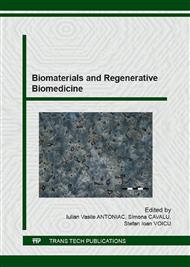[1]
G. Watzek, Implant in Qualitatively Compromised Bone, Quintessence (2004) pp.68-96.
Google Scholar
[2]
C. E. Misch, Contemporary Implant Dentistry, Third Edition, Mosby Elsevier (2008) pp.876-894.
Google Scholar
[3]
D. Busser, 20 Years of Guided Bone Regeneration, Quintessence (2009) p.124 – 132.
Google Scholar
[4]
F. Khoury, H. Antoun, P. Missika, Bone Augmentation in Oral Implantology, Quintessence (2007) p.152.
Google Scholar
[5]
F. Khoury, Th. Hanser, Ch. Khoury, J. Neugebauer, T. Terpelle, J. Tunkel, J.E. Zoller, Greffe osseuse en implantologie, Quintessence (2011): 186 - 191.
Google Scholar
[6]
R. Gruber, F. Varga, M. B. Fischer, G. Watzek, Platelets stimulate proliferation of bone cells: involvement of platelet-derived growth factor, microparticles and membranes, Clin Oral Implants Res (2002)13: 529-535.
DOI: 10.1034/j.1600-0501.2002.130513.x
Google Scholar
[7]
E. Anitua, G. Orive, R. Pla, P. Roman, V. Serrano, I. Andía , The effects of PRGF on bone regeneration and on titanium implant osseointegration in goats: a histologic and histomorphometric study, J. Biomed Mater Res A (2009) 91(1): 158-65.
DOI: 10.1002/jbm.a.32217
Google Scholar
[8]
E. Anitua, R. Tejero, M. H. Alkhraisat, G. Orive, Platelet-rich plasma to improve the bio-functionality of biomaterials, BioDrugs (2013)27(2): 97-111.
DOI: 10.1007/s40259-012-0004-3
Google Scholar
[9]
J. Oliva, X. Oliva, J. D. Oliva, Five-year Succes Rate of 831 Consecutively Placed Zirconia Dental Implants in Humans: A Comparison of Three Different Rough Surfaces, Int. J. Oral Maxillofac. Implants (2010) 25: 336 – 344.
DOI: 10.11607/jomi.10000
Google Scholar
[10]
X. Oliva, J. Oliva, J. D. Oliva, Full-mouth oral rehabilitation in a titanium allergy patient using zirconium oxide dental implants and zirconium oxide restorations. A case report from an ongoing clinical study, Eur. J. Esthet. Dent. (2010).
DOI: 10.1111/j.1752-248x.2008.00029.x
Google Scholar
[11]
S. Tete, F. Mastrangelo, A. Bianchi, V. Zizzari, Collagen Fiber Orientation Around Machined Titanium and Zirconia Dental Implant Neck: An Animal Study, Int. J. Oral Maxillofac. Implants, (2009) 24: 52-58.
Google Scholar
[12]
L. Rimondini, L. Cerroni, A. Carassi, P. Torricelli, Bacterial Colonization of Zirconia Ceramic Surfaces, The International Journal of Oral and Maxillofacial Implants (2002) 17/6.
Google Scholar
[13]
A.E. Bianchi, M. Bosetti, M.T. Sberna, F. Sanfilippo, M. Cannas, The Zirconia Solution: Increa sing Osteoblasts and Fibroblasts Adhesion and Proliferation, The Journal of Applied Biomaterials & Biomechanics (2004) 2: 143-150.
Google Scholar
[14]
E. Anitua, Use of P.R.G.F. ®-Endoret® to accelerate bone and soft tissue regeneration in postextraction alveoli, Dental Dialogue (2006)1/06: 3- 14.
Google Scholar
[15]
J. Oliva, X. Oliva, J. D. Oliva, One-year Follow-up of First Consecutive 100 Zirconia Dentall Implants in Humans: A Comparison of two Different Rough Surfaces, Int. J. Oral Maxillofac. Implants (2007) 22: 430 – 435.
DOI: 10.11607/jomi.10000
Google Scholar
[16]
D. Hagi, Biomechanical and clinical attributes of Zirconia Dental Implants-Two Case Reports, Oral Health (2013). http: /www. oralhealthgroup. com/news/biomechanical-and-clinical-attributes-of-zirconia-dental-implants-two-case-reports.
Google Scholar
[17]
J. Oliva, X. Oliva, J.D. Oliva, Replacement of Congenically Missing Maxillary Canine With a Zirconium Oxide Dental Implant and Crown. A Case Report From an Ongoing Clinical Study, Oral Surgery, 1 (2008), 140-144.
DOI: 10.1111/j.1752-248x.2008.00029.x
Google Scholar
[18]
X. Oliva, J. Oliva, J.D. Oliva, H.S. Prasad, M.D. Rohrer, Osseointegration of Zirconia (Y-TZP) Dental Implants: A Histologic, Histomorphometric and Removal Torgue Study in the Hip of Sheep, Int. J. Oral Implantol. Clin. Res. (2013) 4(2): 00-00.
DOI: 10.5005/jp-journals-10012-1093
Google Scholar


